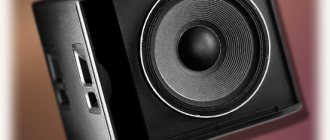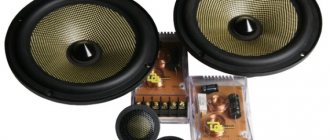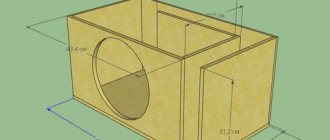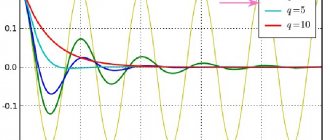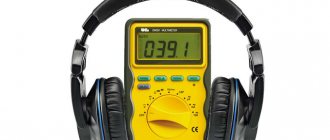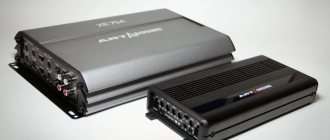What is this parameter for speaker systems?
It’s hard to argue with the fact that sound quality is a subjective concept. For example, the power consumption in watts or the sound pressure created in decibels can still be measured - even in a special laboratory.
Audio sound quality is a relative characteristic. It is impossible to measure it: there are neither reference units that can be stored in terms of weights and measures, nor instruments that record the subjective sensations of the listener.
This sometimes causes online disputes on computer forums or audiophile sites. For an unassuming user, and even one who is a little hard of hearing, even the cheapest Chinese office tweeters can sound divine.
For a person with a fine mental organization and an absolute ear for music, even an expensive quad system for a PC is “not very good”, because it can be better.
The quality of playback is significantly affected by such a characteristic as sensitivity. This is a parameter that determines the efficiency of emitters.
The sensitivity of a sound speaker is characterized as the ratio of the sound pressure created in a certain frequency range, at a distance to the working surface of 1 m, at a power of 1 W. This parameter is measured in decibels.
Roughly speaking, a speaker with a high sensitivity will sound louder than a speaker with a low sensitivity, given the same input signal.
Acoustic transformation - Horn
This method allows you to get low frequencies from a small and lightweight speaker by matching it with the environment. Requires a lot of effort in terms of building buildings. The most competent, but also the most expensive way.
Well-designed loudspeaker systems with really high sensitivity use the last four methods, and sometimes the first. As shown, this requires spending a lot of money, increasing the cost of the system and increasing its dimensions, however, you can do it easier.
Emitter electromechanical coupling coefficient
This coefficient, which is designated BL, depends on the induction in the gap and the length of the conductors in it - those that are affected by the magnetic field. Induction can be increased by increasing the strength or number of magnets, or by decreasing the magnetic gap in any of the planes.
An increase in the length of the conductor is possible by increasing the number of turns of the coil, which leads to an increase in its diameter.
If you increase these indicators without adjusting other parameters, the sensitivity at medium and high frequencies increases. The low frequencies remain unchanged, so this method is not suitable for such speakers.
Illegal way
Let us recall that sensitivity is measured on the axis, at a distance of 1 meter when 1 W of power is supplied. How to get this 1W?
To do this, you need to determine the nominal resistance. It is selected from the range 2, 4, (6), 8, 16, 25 and 50 Ohms. Since the speaker is a complex resistance with a complex dependence of the modulus of the total electrical resistance on frequency, the determination of this resistance obeys the law. For example, this is written in GOST 9010-84 “The measured minimum value of the modulus of total electrical resistance in the range above the main resonance frequency should not differ from the nominal electrical resistance by more than minus 20%.” Thus, the value of the modulus of total electrical resistance of a 4-ohm system cannot be less than 3.2 Ohms, and for an 8-ohm system - 6.4 Ohms, etc.
Then, according to Ohm's law, to measure a speaker with a nominal resistance of 4 Ohms, we must supply 2 Volts (root of 4) to it, 8 Ohms - 2.82V, and for 16 Ohms - 4 V.
In Western descriptions and passports, the column “sensitivity” is often found, with a characteristic of 1m/2.8V, in combination with “resistance”, for example, 6 Ohms. When measured, it turns out that the minimum resistance of such a product is 3.4 Ohms. This means that the system turns out to be really 4 Ohm, and we supply 2 W to it (According to Ohm’s law 2.8V2/4=2W) and get a sensitivity increase of 3 dB. In addition to this, the frequency response, especially of the speakers individually, has areas of dips and rises, which makes it possible to fix the sensitivity precisely in the area of this rise. Not to mention the possibility of simple addition. As a result, we easily obtain an increase in the sensitivity value of 4-8 dB.
Carrying out measurements of acoustic systems from Western manufacturers, including famous ones, unfortunately, showed that this practice is common and is used, with rare exceptions, everywhere.
Weight of moving parts
By reducing the weight of the membrane and other moving parts of the emitter, it can be ensured that it creates greater sound pressure with less effort. However, as such characteristics improve, the system as a whole becomes less durable and its rigidity decreases.
With severe overloads, significant sound distortion and even system failure are possible. In addition, designers are limited by the materials and technologies used: it is impossible to reduce weight indefinitely without losing other characteristics.
Perhaps in the future more advanced technologies will appear that will make it possible to create very powerful speakers of small dimensions.
But why is this being done?
It's all about the low frequencies, because... The level of low frequencies when indicating the frequency range in the passport, and when listening, is calculated precisely from the average sound pressure level - sensitivity and, therefore, systems with real low sensitivity have a gain in the number and depth of low frequencies.
And it is very difficult to achieve deep low frequencies and high sensitivity with a certain size of speakers and acoustic systems. After all, you can’t write a sensitivity of 80 dB in your passport, no one will buy it! It is much easier to write a normal sensitivity level and provide the client with powerful bass when listening.
This text was written not to accuse anyone of falsification, but to provide the consumer with more complete information.
How to check equipment in the salon →
← The difference between Hi-Fi and Hi-End
Of all the characteristics of speakers and acoustic systems, the concept of “sensitivity” is perhaps the most interesting and attractive (in this it competes with the power characteristic). I just want this concept to have a direct relationship to the quality of the speaker, i.e. The higher this parameter, the better the speaker sounds. After all, an acoustic system is a device for reproducing music, and its quality is often determined only subjectively, and sensitivity - from the word feel, feeling well, subconsciously, merges with the word quality. However, we know that this is not true. First of all, this concept is purely technical, reflecting the efficiency of the speaker. According to GOST 16122-78, the characteristic sensitivity of the speaker is the ratio of the average sound pressure developed by the speaker in a given frequency range (usually 100 ... 8000 Hz) on the operating axis, reduced to a distance of 1 m and an input electrical power of 1 W. Of course, if we have a speaker with a higher sensitivity, then by supplying 1 W we will get more sound pressure than from a speaker with a low sensitivity, less nonlinear distortion and, probably, higher sound quality. However, it is worth thinking about how this sensitivity was obtained?
We have several legal (real) and illegal (marketing) ways to increase sensitivity.
Real ways to fight sensitivity
Speaker systems with a large number of speakers
When several speakers (acoustic systems) are connected in parallel (series), the volume level increases (the power also increases). It is used for sound systems and due to the uneven characteristics of wideband speakers, the sound quality remains low. The method is often used in acoustic systems where 2 or more low-frequency speakers are used per high-frequency speaker. In this case, the main problem is the characteristics of the directionality of such a system.
Increasing the sensitivity of single speaker systems
A speaker or acoustic system is an electro-mechanical-acoustic converter and, as a result, it is possible to increase the efficiency of the system at each stage of this conversion.
Electro-mechanical coupling coefficient (BL) dynamics
The first stage is electro-mechanical conversion. For this purpose, the “BL” coefficient has been introduced. It depends on “B” - the induction in the gap and “L” - the length of the conductors in this gap (or the number of conductors on which the magnetic field acts). “B” can be increased by increasing the volume and strength of the magnets, reducing the magnetic gap both in height and width. “L” - increasing the diameter of the coil and the number of turns in height in the gap. If you increase the “BL” value without changing other characteristics of the speaker, the sensitivity in the area above the main resonance of the speaker will increase, and the low-frequency capabilities will remain unchanged.
Weight of the moving system
By reducing the mass of the moving system, we can create more pressure than with a larger mass. This improves impulse and transient characteristics, but reduces strength (power), rigidity (nonlinear distortions may increase) and will require the use of new materials and technologies. Obtaining low frequencies, especially deep ones, requires a lot of effort.
Radiation area
Increasing the diffuser area leads to an increase in the level of sensitivity, but problems arise with the reproduction of high frequencies and structural strength.
Acoustic transformation - horn
This method allows you to get low frequencies from a small and lightweight speaker by matching it with the environment. Requires a lot of effort in terms of building buildings. The most competent, but also the most expensive way.
Well-designed loudspeaker systems with really high sensitivity use the last four methods, and sometimes the first. As shown, this requires spending a lot of money, increasing the cost of the system and increasing its dimensions, however, you can do it easier.
Illegal way
Let us recall that sensitivity is measured on the axis, at a distance of 1 meter when 1 W of power is supplied. How to get this 1W? To do this, you need to determine the nominal resistance. It is selected from the range 2, 4, (6), 8, 16, 25 and 50 Ohms. Since the speaker is a complex resistance with a complex dependence of the modulus of the total electrical resistance on frequency, the determination of this resistance obeys the law. For example, this is written in GOST 9010-84 “The measured minimum value of the modulus of total electrical resistance in the range above the main resonance frequency should not differ from the nominal electrical resistance by more than minus 20%.” Thus, the value of the modulus of total electrical resistance of a 4-ohm system cannot be less than 3.2 Ohms, and for an 8-ohm system - 6.4 Ohms, etc. Then, according to Ohm's law, to measure a speaker with a nominal resistance of 4 Ohms, we must supply 2 Volts (root of 4) to it, 8 Ohms - 2.82V, and for 16 Ohms - 4 V.
In Western descriptions and passports, the column “sensitivity” is often found, with a characteristic of 1m/2.8V, in combination with “resistance”, for example, 6 Ohms. When measured, it turns out that the minimum resistance of such a product is 3.4 Ohms. This means that the system turns out to be really 4 Ohm, and we supply 2 W to it (According to Ohm’s law 2.8V2/4=2W) and get a sensitivity increase of 3 dB. In addition to this, the frequency response, especially of the speakers individually, has areas of dips and rises, which makes it possible to fix the sensitivity precisely in the area of this rise. Not to mention the possibility of simple addition. As a result, we easily get an increase in sensitivity of 4-8 dB. Carrying out measurements of acoustic systems from Western manufacturers, including famous ones, unfortunately, showed that this practice is common and is used, with rare exceptions, everywhere.
Why is this being done?
It's all about the low frequencies, because... The level of low frequencies when indicating the frequency range in the passport, and when listening, is calculated precisely from the average sound pressure level - sensitivity and, therefore, systems with real low sensitivity have a gain in the number and depth of low frequencies. And it is very difficult to achieve deep low frequencies and high sensitivity with a certain size of speakers and acoustic systems. After all, you can’t write a sensitivity of 80 dB in your passport, no one will buy it! It is much easier to write a normal sensitivity level and provide the client with powerful bass when listening.
This text was written not to accuse anyone of falsification, but to provide the consumer with more complete information.
Welcome to the Car Audio Forum »
Conclusion
Before you go shopping for car speakers, you need to answer a couple of questions for yourself:
- what type of sound system is needed?
- What is the maximum allowable size of acoustic elements?
The answer to the first question determines the sound quality, and the second - the possibility of installing the system.
If you are interested in high-quality and clear sound, it is not always provided only by expensive speaker systems. Some models of budget acoustics sound quite decent. In terms of powerful and flawless sound, it is expensive but worth it.
Also, the quality of the acoustic design will depend on where exactly you install the speakers, but here you will have to experiment.
Location
Building a sound system within a limited space, which is the interior of a vehicle, does not look like a simple process. If at home you can simply move the speakers to the sides, then this will not work here. The speakers in the car must be installed correctly. Only compliance with a certain installation scheme and rules can lead to truly high-quality sound.
The basic rules for installing acoustics are as follows:
- the speakers should be placed as far forward as possible;
- To obtain a consistent sound, speakers with different frequencies must be installed in close proximity to each other.
Almost all cars have special places for installing speakers:
- doors – high frequency;
- rear of the car – midbass.
The most common scheme is when the speakers are installed at the rear. If this is the case, then you should separate the subwoofer and speakers at a sufficient distance. The optimal implementation of such a scheme is when the speakers are placed in the rear doors, and the subwoofer in the trunk. The front of the car is suitable for installing mid- and high-frequency speakers. For example, a suitable place for such speakers is close to the mirrors.
In any case, the operation of powerful acoustics contributes to the generation of extraneous noise as a result of the rattling of doors. This situation can be corrected by carrying out vibration and sound insulation work. If you do all this to the maximum, then not only will unnecessary noise in the cabin disappear, but the sound will also gain depth. Carrying out such a procedure requires high-quality materials, and this is expensive.
At the same time, even partial insulation of doors against excess noise with an addition such as wooden rings allows you to save money. You can install inexpensive speakers and get sound comparable to that produced by expensive acoustic models installed in standard places.
The installation of acoustics in a car is usually initiated by the driver himself. It is he who is the main listener, which forces him to position the speakers taking into account his location in the cabin. To do this, mid- and high-frequency speakers should be placed not just in front, but at the greatest distance from the listener. This allows you to make a podium mounted on the dashboard.
Attention! The required soundstage width is achieved when the tweeters on the front pillar are positioned at a certain angle. Usually they are directed at each other.
When the speakers are located throughout the car, the sound they produce reaches the driver's ears at different times. To avoid this, a temporary correction is required. It is provided through the appropriate processor, which is equipped with the radio or is installed separately. The sound quality in no way depends on the processor itself. It only gives the opportunity to evaluate its quality to someone who physically cannot be in the center in relation to the speakers.
